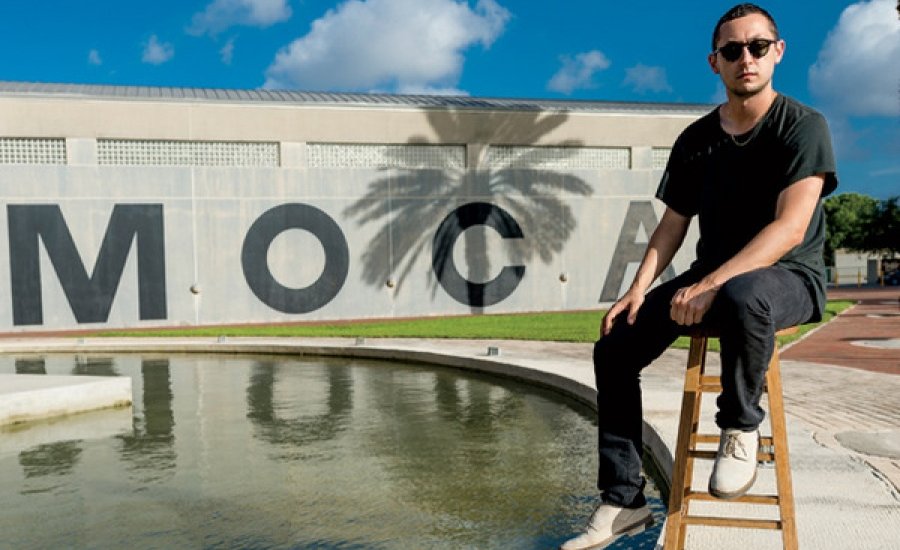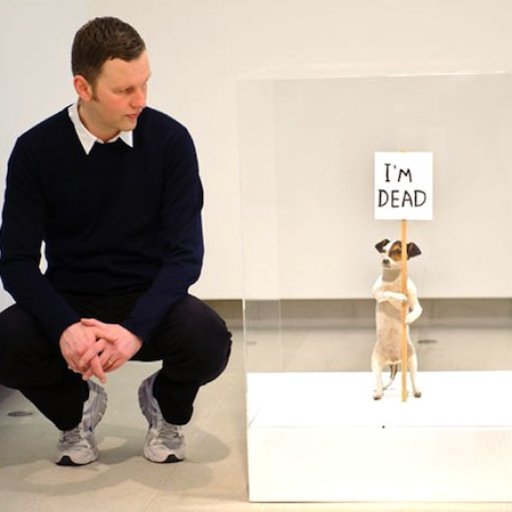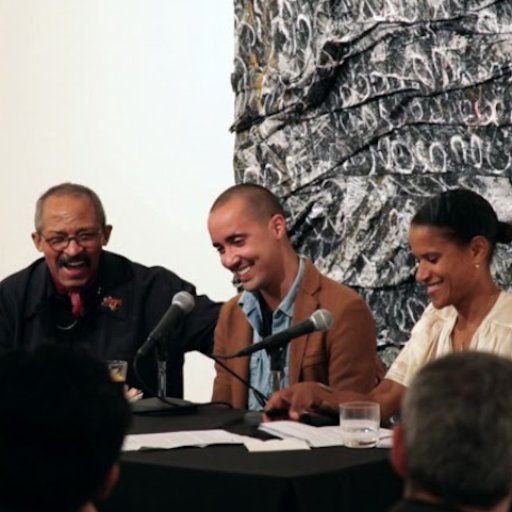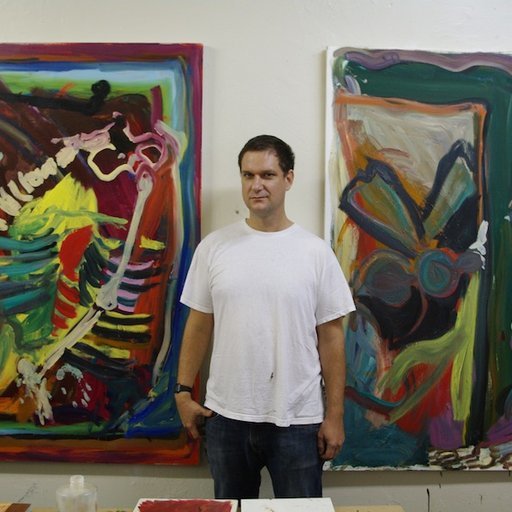In a few short months this year, critic and curator Alex Gartenfeld went from being an editor at Art in America magazine in New York to being a curator at North Miami's Museum of Contemporary Art to—following the departure of that institution's longtime director, Bonnie Clearwater—taking the reins as interim director in August. It's a remarkable rise for the 26-year-old talent-spotter, who first garnered attention for the small-scaled exhibitions of emerging artists that he produced in his apartment. Now that he is at the helm of a well-regarded museum with a reputation for ushering new artists into the limelight, many in the art world are curious to see what he will do next.
To find out about his plans for the institution, and to hear about the shows he has in the works—including the new Tracey Emin exhibition, initiated by Clearwater, that opens during Art Basel Miami Beach—Artspace editor-in-chief Andrew M. Goldstein spoke to Gartenfeld about what he has in store, and how he views his new perch.
This August, you were made the interim director of MOCA North Miami. What does that mean?
An interim is an abstract period. We had a great, visionary director for 19 years in Bonnie Clearwater, who built the reputation of the museum to a great extent. Over that time, the museum has grown tremendously, and will continue to grow tremendously because we have such a strong mission, which is unique in the Miami community. We’re evaluating all our options in terms of what that means, how we put on the best exhibitions, how we continue to be a leading international art institution, and how to best present our collection.
That involves a lot of really deep consideration on a number of levels, and one of the questions is who the director should be. I’m a part of the discussions, and we have an amazing board of trustees who are really forward-thinking. In the meantime, I am running the exhibition program as well as the operations at the museums, which means creating new fundraising initiatives as well as maintaining our membership campaigns. It also means making sure that we have a strong, world-class staff, and that each department is creating and maintaining a budget.
It means a lot of things, operationally. It means that I’m in charge of internal and external affairs. It’s a fun challenge. There’s a PR line that I’ve been saying from the beginning, which is that I came down to Miami to grow with the institution, and the institution took me up on it. It’s been a fun process learning the ins and outs, and learning along the way, and inventing along the way as well.
For a long time you were known primarily as an art journalist, working as an editor for Art in America and Interview magazines. How and when did you first start curating shows?
It was even before Art in America, actually. I had just finished school, and I was sharing an apartment with a curator and colleague: Piper Marshall who works at the Swiss Institute. At the time we felt that we were amidst an exciting group of colleagues, both generationally and inter-generationally. So we thought setting up shop and creating exhibitions out of a shared apartment would be an important thing that we could do. It was a raw, poor operation—it was completely non-commercial, really just for the love of it, in a tiny, 250-square-foot apartment on the Lower East Side. We called it Three's Company, and we had exhibitions in our bedrooms. It was right across the street from all these amazing artist studios. It all sounds very romantic, looking back.
Who were the artists you showed?
Leigh Ledare, Richard Aldrich, and Lisa Tan were in the first one. That was a pretty early show for Rich, though he had already shown with Oliver Kamm. It was an early show for Leigh, who had just finished school. And Lisa Tan, who did a show at D'Amelio Terras later that year. Then we did a show with AIDS-3D at the same time they were included in the New Museum's first "Generational" show, "Younger Than Jesus." It was a little fellowship where they turned the entire apartment into a bong. We did a show with Asher Penn, and the last thing we did was a show called “Middle Man” with Dan Graham, John Miller, and Nicolas Guagnini. It was the realization of a project which Dan had scripted—he had predicted an exhibition of that type to occur, and so we realized that exhibition and created a catalogue with updated text by myself and Piper.
Where did your curating go from there?
Through Three's Company, I very nicely began to get invited to make other exhibitions. I was generously supported by people who were commissioning projects, and I got opportunities and very open prompts to make exhibitions. But at that stage in my life, I still felt that I needed a space of my own for the artists I was working with, and I also starting to work with a whole new group of artists at that time. So a few months later, I started West Street Gallery with Matt Moravec. I’m working with a number of those artists. We were really interested in supporting the work of other colleagues, and we came out with a complimentary sensibility instead of objective. The project worked for about two years.
You both lived in the apartment?
I lived there for the first few months, and then I moved elsewhere. It became more of a blank slate as time went on.
It's impressive how many rising stars you included in your shows at the beginnings of their careers—many of them were just getting out of art school and just starting to make work at the time, and now are among the more sought-after artists of their generation among insiders of the downtown art scene. Artists like Sam Falls, Zach Kitnick, and Kon Trubkovich, for instance, not to mention Aldrich and Ledare, who are now quite famous.
Yeah, isn't that quite nice? Sometimes you almost don’t know when something is going to have legs, but when it does its very satisfying. But Rich was in the works way before us—I can’t take any credit for that. Sam Falls is an amazing artist, and it was an amazing time to be working with him. First of all, his photography practice was incredibly precocious. He was making these painted-on photographs that were just completely in their own class. But while he was working at this incredibly high level, at the same time, his practice was changing. He started off with this one great idea, and then he created an entire new way of making work. He kept inventing, and it was really exciting. It was almost a vertiginous experience to be working in that time and place with him because his practice was evolving at such a tremendous rate.
How did you pick which artists you worked with? How did they come into your orbit?
Well, the most important thing for any exhibition I do is to be in a very clear dialogue with artists and working collaboratively with them. Studio visits were a really significant part of that process and generated a lot of that dialogue. It’s not magic. You go to the studio, and, if the artists are generous enough to let you into their work, you embark on a discussion. You hope or sense that there’s a connection, and you talk to them about ideological concerns or what their practice might involve. The work that is in agreement with your ideas of practice is the work that you show. Art is all about immanence, and you have to make sure that the scenes that are being parsed are being done so effectively.
How did your curating coexists with your work as an art critic and journalist?
Well, I never thought of myself as journalist. I started writing at a very early age, and I’ve always learned on the job, but I never really did any journalistic work, to be honest. I never broke a story. I started writing reviews and criticism, and as my writing practice evolved and as my critical practice evolved, some of the ideas became more substantial. I was quite lucky to have an employer at Art in America and Interview who was respectful of my objective and allowed me to take off time in order to make exhibitions and maintain dialogue with artists. The employer also saw it as an asset. Even now I’m still a contributing editor for Art in America, and I maintain contact with them and try to be as helpful as I possibly can. There's a natural overlap between critics and curators in terms of making decisions about what material is significant as it occurs. I have been able to do both of those things at the same time.
When you were running your galleries, you had a great deal of success attracting collectors to your program, despite how small the spaces were. Now that you have to work so closely with collectors and art patrons on the museum's board, that experience must have been valuable.
Collectors are people, too. Some of my closest friends are collectors. Many people who are intelligent and critically engaged collect art and think that it’s an important thing to do and an interesting way to support artists. So I have never felt at odds with the spirit of collecting, even though I think that it is important for collectors to be critical and self-reflexive about what they do. But, in fact, my first project out of school was working for a couple of private collectors who are very involved with artist’s books and have a world-class collection of serial artist publications. They commissioned me to write a book for Printed Matter and to research the subject and create an anthology of artist publications. I was really lucky to have that introduction to people as thoughtful about collecting as they are.
How did you first attract MoCA's attention as a curator?
Bonnie Clearwater had seen a number of my shows, and we had established a relationship because we had a number of friends and colleagues in common. So she reached out to me, and it went from there.
What has it been like transitioning from apartment galleries and a magazine office to a major museum? What have the institutional challenges been?
It’s been very fun. As for challenges, I’ll focus in on one. Miami is this incredibly dense, interesting, international city. It’s a very new city. There are a lot of people who are incredibly intelligent and established in their fields, and some of them may be well-versed in contemporary art, but generally there’s a tremendous amount to do in terms of cultivating a museum culture here. That’s really exciting because you can lead your members, patrons, and supporters towards a new vision of a museum and of a city.
Another challenge is generating support for local artists and encouraging them to embrace a level of international dialogue. Miami has great artists—the challenge is to make sure that the institutions, both in terms of exhibitions and other programs, are capable of educating these artists and making sure they are familiar with international currents in contemporary art. That’s a specific challenge which is very different from what you find in New York.
How is MoCa NoMi going to… hold on, does anyone at the museum actually refer to it that way?
I don’t. I hate that name. I call it MoCA.
Ok, how is MoCA going to change and morph over the next couple of years?
I think it will grow tremendously. I think there’s a lot of support for the museum, and I think we're seeing that have an impact already. I think that the mission of the museum is very important and unique here in terms of an American institution devoted to presenting the work of emerging and underrepresented established artists. I can count on two hands the number of institutions that do that in the United States, so carrying on that history, not only through exhibitions but also through growing the collection, is hugely significant. For its currentness and its ability to break talent and present work that is unique and cutting-edge, the museum stands apart from the crowd in South Florida and on the international stage.
What is the collection like?
The collection involves about 800 pieces of work. There are two prongs. The first is that a lot of works in the collection track artists who have presented here at MoCA, so there is a living history of the museum and its place in the community. That’s the most fun part of the museum. The second is that it’s very international while at the same time being committed to the local, and MoCA has been the first to support a number of local artists through its collection.
I thought it was interesting that your first show at the museum was “Love of Technology,” based on the interplay between human beings and high-tech processes. How important do you think an engagement with technology is to artists who are trying to push the contemporary art dialogue forward?
The exhibition came about because there were so many shows that I've done that have dealt technology in a really narrow sense. Technology and the topicality of it is ubiquitous these days—it verges on absurdity. For instance, I’m curating an exhibition with Ryan Sullivan, his first institutional solo show. Ryan is an artist who works within the medium of painting, although he approaches it from a unique position formed by currents in mid-century painting via AbEx and even Dieter Roth. But he frames what he does against the backdrop of digital photography. So even he, an artist working in a non-digital medium, has to keep technology in his rearview mirror in order to make sure that his paintings are both unique and still relevant. It addresses technology in a very abstract way.
The DIY environment of your apartment galleries very really appealing, and it seemed to really color the kinds of shows that you had. Is it possible to transfer that kind of approach to a museum like MoCA?
Firstly, MoCA is a small institution that has deep roots in the community—anyone in North Miami is a member here, so they can walk in off the street and feel at home in the museum. It really depends on what you consider DIY. We have a tiny staff and we’re doing it all ourselves. Another way of understanding DIY is to present work that’s really new and fresh and close to the ground. That’s what MoCA’s mission is. We do that through group exhibitions, especially ones that show emerging artists, and through monographic shows. Ryan Sullivan is 30 years old, so there’s a certain freshness and DIY-ness to that as well.
There are also shows like your new Tracey Emin survey, her first survey in the United States.
Yes. Tracey runs her studio in an incredibly precise way. She is the decision-maker in terms of the distribution of her work, and it’s incredible to watch. Her form has extended. It’s all Tracey—she’s very much the artist, and she very much has a vision that she’s executing. That’s why neon, which is the focus of this exhibition, is perhaps such a significant medium for her. There’s a response to vernacular culture there. Neon can be considered a readymade, but it’s also a transcription of Tracey’s personal writing. So in that gesture of creating a readymade, there is this internal tension between the rawness of her writing and the commercial production of neon. And she’s made a beautiful layout. She’s painted all the walls blue, the whole thing will be carpeted, and the entire room will be lit only by the luminescence of the neons. It will be a cacophony of light.
So what’s down the line? Any biennials, triennials, or art prizes?
That’s a good idea. But I’m less concerned about that, actually, than I am with presenting the work of emerging and underrepresented artists. Our priority for the time being is to stay true to our mission. But one thing we are doing is that we will be presenting the first international symposium on Nollywood films in 2015. The Nigerian film business is a huge international industry that has never had substantial academic representation or research. We’re really excited about it. I also several public programs that will be addressing issues of urbanism and the city of Miami that will include international voices, as well as artists like Shannon Ebner. It should show a different side of the museum.
























